HERE IS A SHORT ILLUSTRATED HISTORY
AS A PDF: How Welfare was Won
AS A 17 MINUTE VIDEO
AND HERE IS A LONGER HISTORY OF THE PREWAR PERIOD:
A History of Unemployment in Scotland
Over the last century, Governments were persuaded that they had to play a part in making life easier for people who were out of work, but the old ideas didn’t go away. They have gained a new lease of life – and the old Scots description of unemployed people as feckless is popularly used by modern politicians. These old arguments have long been countered by the unemployed themselves and by the wider labour movement. The improvements described in this history only happened because of organised pressure from below; but many past improvements are now under attack, and the fight goes on.
BEFORE THE FIRST WORLD WAR
Industrialisation and unemployment
In nineteenth-century Scotland, rapidly expanding industry and industrial towns generated new forms of abject poverty on an unprecedented scale. Those who could not make ends meet had to hope for private charity or help from the temporary relief schemes that were organised in times of exceptional crisis – or fall back on the Poor Law. The 1845 Poor Law (Amendment) Act stated that the able-bodied unemployed had no rights to any help. Despite this, some parishes did provide some help to the unemployed, but other parishes challenged this in court. The House of Lords made clear that no help could be given to an able-bodied unemployed man or to his family, even if they were ‘destitute of the means of subsistence’. Parishes continued to show a degree of leniency, but from the mid 1860s rules became more severe. More people were refused help, and of those that were helped, more were forced to go into the poorhouse (the Scottish version of the English workhouse). This was regarded as a test that would put off all but the most desperate. Inmates lived in barracks on starvation rations and were forced to do tedious menial work. The poorhouse was deliberately unpleasant and demeaning.
By the later years of the century the power of the growing working class was beginning to have an impact on political decision makers. Politicians had to demonstrate a response to working-class interests to make workers feel that they had a stake in the system. The increase of the franchise (by 1885 60% of men had the vote) was a reaction to the growth of working-class power, and helped strengthen it further. Labour movement leaders were arguing for a different understanding of unemployment; and their arguments were reinforced by evidence produced by the various Royal Commissions set up to examine the causes of poverty. Governments were spurred into taking action by the fear of growing unrest as well as the desire to undercut support from their Labour rivals. Following riots by unemployed workers in London in 1886, the government encouraged local authorities to use public works to provide employment at times of depression. There were also attempts to provide work on subsistence wages through labour colonies. But actual achievements were very limited and resistance to more significant help for the unemployed remained strong. While Glasgow Trades Council told an 1895 parliamentary committee that unemployment should be blamed on economics and the unemployed should be helped by state benefits, Glasgow’s Inspector of Poor put the blame firmly on the moral character of the unemployed. ‘The contest is not with industrial conditions,’ he told the committee, ‘but with original sin’.
Nevertheless, ten years later industrial conditions, combined with pragmatic politics, had forced some government concessions. Economic depression had produced demonstrations by the unemployed and made unemployment a burning election issue. The outgoing Conservative government passed the 1905 Unemployed Workmen Act, and set up a major Royal Commission on the Poor Laws. The 1905 Act provided low-paid temporary work. It did not apply to all workers or all places and only lasted 3 years. However it was important in recognising the government’s responsibility to help able-bodied unemployed workers. The Royal Commission helped to change ideas and understanding. It completed its report in 1909, and one of the first results was the setting up of a system of state-run labour exchanges.
National Insurance

National Insurance Stamp, 1912
The start of more significant change can be dated to 1911 and the introduction of National Insurance. This was and still is a source of pride for the Liberal Party, but it would not have happened if the Labour Party and wider labour movement had not been hard on the Liberals’ heels. For many socialists and trade unionists, National Insurance was not their preferred solution, but it was the growing strength of the labour movement that ensured the problem of destitution in unemployment began to be addressed. The Liberals were worried about losing votes to the Labour Party and wanted to keep their working-class support. Added to this, the economy was in depression and government was concerned to preempt further unrest. Before 1911 a very small proportion of workers had been insured against being out of work through voluntary friendly societies or their trade unions. Now insurance was made compulsory for all workers in a range of occupations characterised by irregular employment, including construction and shipbuilding. This covered around 2 ¼ million people across the UK. Additional insurance contributions were made by the employers and by the government. National Insurance covered sickness, disablement and maternity benefits as well as unemployment. Benefits were only available to workers who had already made sufficient contributions, and unemployment benefit was small – not intended to be enough to live on – and only paid for a maximum of 15 weeks in a year. During the First World War national insurance was extended to cover around 4 million workers, of whom ¼ were women, but this was still a small minority of the total workforce.
THE INTER-WAR YEARS
Economic failure and fear of unrest
The wartime government was worried about possible social breakdown following mass demobilisation, and already by 1915 they had promised that after the war there would be financial help for soldiers as they looked for work. Their fears were increased by wartime unrest and the example of revolution in Russia. The first government out-of-work payments (or dole because they were doled out) were made to ex servicemen in 1918, and they were soon extended to cover many civilian workers. These were means-tested payments lasting 26 weeks, and meant to cover basic subsistence, including for dependents. This was only a short term arrangement – ending in 1921 – for what was expected to be a temporary problem, but it set an important president.
In 1920 compulsory unemployment insurance was extended to cover 12 million out of Britain’s 19 million workforce. (There was still no insurance for farm labourers – who were not included until 1936, nor for domestic servants – not included until 1937.) But reliance on an insurance-based system was immediately proved inadequate. Already by the autumn of 1920, when the extensions came into effect, the short post-war boom had gone into reverse, and, contrary to government expectations, the interwar years became a time of deep economic depression and prolonged structural unemployment. Scotland, with its heavy industry, was especially badly hit. By July 1921, ¼ million Scottish workers were out of work.
Through the Twenties and Thirties, policy towards the unemployed evolved through piecemeal disaster management in response to economic failure and fear of social unrest. (There were no fewer than 18 Acts making changes to Unemployment Benefit between 1920 and 1930.) By the outbreak of the Second World War the main post-war benefit structures were already in place, but the level of help was low. Organised protest had helped force concessions and resist reversions, but had had to contend with governments in thrall to the City and the market and bound by economic conservatism. The risk of a family on benefits being better off than a family with someone in work was used to justify benefit levels that were well short of calculations of the most minimum human needs.
Organising the unemployed
The problem of unemployment was kept in the political foreground by an organised and militant unemployed movement. The movement benefited from the disproportionate sacking of trade-union activists, who were able to use their experience to organise other unemployed workers. There were many angry and desperate people who welcomed the opportunity to take action. Harry McShane described a demonstration in Glasgow in 1921 when some of the men carried hand grenades they had brought back from the war.
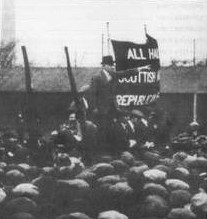
John Maclean, Glasgow Green, May Day 1923
John Maclean, who had previously led demonstrations of unemployed in 1907, established the Glasgow Unemployed Workers Movement with the help of McShane in 1920; and by February 1921 they were organising a conference of unemployed committees from across Scotland. They felt that the Labour Party and trade unions were not doing enough and that the unemployed needed their own organisation. When Maclean was asked at his 1921 trial ‘How did you come to organise the unemployed’, he replied ‘Because nobody else would’. They kept up a campaign of demonstrations and militant action; and even persuaded the city council to let three and a half thousand unemployed meet twice a week in the City Halls to – as Maclean described in an Open Letter to Lenin – ‘discuss principles and tactics applied to the present situation from a Marxian point of view’. While limited concessions were one response to unrest, the authorities also relied on a heavy use of the forces of law and order. By the autumn of 1921 MacLean was beginning a year in prison. His crime this time had been to urge the unemployed to take food rather than die of starvation. With MacLean incapacitated by prison and then by his fatally weakened health, organisation of the unemployed became dominated by the Communist Party, and by the end of 1921 the Scottish movements had become part of the National Unemployed Workers Movement (NUWM). This had a Communist Party leadership, but was a mass organisation with the great majority of its members and many of its activists unconnected to the Party. Central to the NUWM’s campaigns was the demand for work or full maintenance paid at trade union rates. Members also swore to strive for the abolition of capitalism.
The NUWM combined protests and demonstrations with grass-roots work helping individuals extract the help due to them and helping destitute families resist eviction. They put pressure on central government and on local parishes, holding meetings outside the labour exchanges and parish relief offices and helping to organise unemployed workers into large targeted demonstrations. Relations between the NUWM and the Labour Party and TUC were frequently strained, or worse. There was help from local Labour councillors, but although, thanks to the widening of the franchise in 1918, Labour benefited from the votes of unemployed workers, the two short-lived Labour governments carried out only relatively timid reforms. The established labour movement did little to organise the unemployed themselves but were wary of the NUWM, choosing to focus on the respectable path of parliamentary socialism and to avoid too close an association with confrontational protest or with communists. They did work with the NUWM effectively from 1922 to 1925, though the TUC rejected the NUWM’s request for affiliation. But in September 1925 Communists were expelled from the Labour Party, and in 1927, after the TUC turned to the right following the General Strike, they severed all links with the NUWM. By 1929, when the Labour Party barred NUWM members from being elected as delegates to Labour Party meetings or speaking at Labour-organised public meetings, an even stronger separatist drive was coming from the Communist Party. Between 1928 and 1933 the Communist International regarded the non-revolutionary left as traitors to the cause and enemies of Communism. The NUWM was less affected by these attitudes than most Communist organisations, but they naturally made it harder for trust to be re-established when the Communists reversed their position and began to push for a ‘popular front’. In 1934 the TUC issued its ‘Black-Circular’ forbidding trades councils from accepting Communist delegates and asking unions to exclude Communists from official positions, though responses to this request varied. Had the NUWM and the wider official labour movement continued working together, the impact could have been much stronger; but even as it was, the unemployed movement was big, well-organised and determined. It gave a voice to thousands who had no-one to represent them and it found a resonance with thousands more ordinary workers. It could not be ignored.
Although governments stuck to the idea that unemployment was a temporary problem that would go away with improvements in the market, and that the market should not be interfered with; they found themselves compelled to provide material help to the unemployed. This was done through changes in benefits and in the Poor Law.
Ad hoc changes to benefits
In 1921, following major agitations, the government added a dependents’ allowance to unemployed benefits and extra periods of benefit were awarded to those whose 15 weeks insured benefit had run out or who had only paid a bare minimum of insurance payments. These extra payments quickly took the insurance fund into deficit, but it was thought, as with so much of this policy, that this would be a temporary measure, with the cost covered by future contributions. In fact, this ad-hoc system was to continue for many years. Rules about eligibility for the extra benefits left unsupported gaps between periods of benefit, which were the source of bitter protest but not finally ended until 1924 and the first Labour Government. In 1927, with the economy seeming to recover, this dual system was continued, but the standard benefit for unemployed workers who had paid a certain number of insurance contributions was extended to cover an unlimited period. Extra benefits that were not covered by insurance were subject to a means test (from 1922), and although this was stopped by the 1924 Labour Government it was reintroduced in 1925 by the Conservatives. Recipients of extra benefits were also required to prove that they were genuinely seeking work. Initially, this impacted particularly severely on married women who did not want to go back into domestic service. In subsequent years the rules were made increasingly harsh to eliminate ‘scrounging’ and reduce the cost of benefit payments by disqualifying growing numbers of applicants.
Getting relief from the parish
Unemployment benefits were inadequate in both size and coverage. Those who fell through the benefit gaps had to rely on charity and relief schemes, but whereas in England the Poor Law provided an ultimate, if severe, safety net, Scottish parishes were not allowed to help the able-bodied. These rules were challenged by major protests of unemployed workers against the parish authorities. The protestors received help from sympathetic Labour councillors, but faced strong resistance from rate-payers and from banks unwilling to loan money for unemployment relief.
In the late summer of 1921 several parishes began to give relief to the able-bodied unemployed, and when Ballingry in Fife withdrew their promised support in response to threatened legal action from rate-payers a deputation from the Miners’ Union persuaded the Scottish Poor Law Board to concede that it might ‘be expedient as being less costly’ to give some preventative aid before recipients became actually physically disabled. An autumn of mass action and riot swept through Scotland’s urban centres and smaller parishes, led off by three days of rioting that took control of Dundee city centre. By mid September the majority of industrial parishes had been forced to agree to give assistance. Labour councillors in Blantyre, which had been the first parish to give relief to the unemployed, tried to go further by extending help to low paid workers who would otherwise have received less than those out of work, but this was not tolerated by the Poor Law Board and the council was left to resign in protest. In November a new Act regularised the temporary use of the Poor Law to assist Scotland’s unemployed. Unemployed workers, who were suffering severe deprivation, continued to fight for more substantial relief, and also to defend previous gains, as parishes attempted to reduce relief in response to the pressures of rate-payer anger and of growing debts. Protest and riot succeeded in reversing some cuts, but the Poor Law Board would not support a parish’s loan applications where it felt benefits were too generous. The inadequacy of the benefits system meant that large numbers were being forced to turn to the parish. In Glasgow, by 1924 almost half the working-class population had been forced to rely on some form of poor relief.
The first hunger march
The hardships of the unemployed were brought dramatically to public notice through the NUWM’s great hunger marches. The first national hunger march took place in the autumn of 1922, with the first contingent of marchers leaving Glasgow in mid October. These 300 men, drawn from across Scotland, had to march for a month to reach London, where they were joined by other contingents from all over Britain. At each town where they stopped they held a public meeting – and insisted that the parish officers provided board and lodging. Thousands of Londoners welcomed the marchers in Hyde Park, and five days later, with the papers full of scare stories of potential revolution, 70,000 people came out to support the hunger marchers as they attempted to demand an interview with the prime minister. When he refused to meet them and – despite the efforts of Labour MPs – the House of Commons refused to hear them, the marchers stayed on in London for 5 months to press their cause and ensure that the unemployed could not be forgotten. Although some of the marchers had to return to care for their families, their places were taken by new arrivals; and while they remained in the capital, they kept busy with direct action protests that often ended in conflicts with the police. There were still 500 marchers in London when they decided to allow the London local authorities to pay their train fares home. Looking back, Wal Hannington, who was the National Organiser of the NUWM believed that this great march made the government abandon thoughts of further cuts and helped prepare the ground for the election of the first Labour government in January 1924.
Labour in government
The change of government did not imply any let up in campaigning. Pressure was now put on the new administration to enact laws that would make a real difference to the unemployed. This was the time when the NUWM was working most closely with the TUC, and they drew up a joint Unemployed Workers’ Charter. In this atmosphere, Labour’s short-lived minority government stopped the means test for uninsured benefits (as noted above) and increased benefit levels. It began plans for some work schemes, and instigated a significant new programme of council house building. However, it also extended the requirement to demonstrate that they were ‘genuinely seeking work’ to all those receiving unemployed benefits, including those on insured benefits who had previously simply been required to accept any job offered. This requirement was to become the source of widespread hardship.
The late 20s, the ‘not genuinely seeking work’ clause and the second Labour Government
Applicants for benefits had to prove that they were actively looking for work. Even after days tramping across the country in search of non-existent jobs, it could be difficult to provide concrete evidence, and officials became expert at quick-fire questioning calculated to make the most innocent claimant trip over the details. The ‘not genuinely seeking work’ clause was used to disqualify increasing numbers of unemployed workers – and even more after 1928, when a new act tightened the rules further even while prolonged protests had managed to limit the severity of the accompanying benefit cuts.
Families who were refused benefits were forced to apply for help from the parish, but in the harsh climate following the 1926 General Strike, there were increasing attempts to test applicants’ genuine need for parish relief by making them go into the poorhouse or undertake relief work for less than trade union wages. The NUWM had always resisted this ‘work test’ from the perspective both of those forced to work on poverty wages, and of employed workers whose wages were undercut and whose jobs were put at risk. In 1928 they helped Glasgow’s relief workers go on strike.
The ‘rationalisation’ of industry was throwing even larger numbers out of work. In the four years from 1924 to 1928 the number of miners employed in the Scottish coal fields fell from over 140,000 to 90,000. In September 1928 unemployed miners were joined by unemployed shipyard workers and jute workers in a march to Edinburgh to raise their concerns with the Scottish Board of Health and Minister of Labour.
The second national hunger march in 1929 especially aimed to draw attention to the impact of the ‘not genuinely seeking work’ clause. Although it set off in the January blizzards, this and subsequent marches were much better organised than the first one. Care was taken to make sure individual marchers were properly equipped, a ‘red cross corps’ tended any casualties, and each contingent was accompanied by a truck with a field kitchen. Discipline was strong and the men, many of whom had fought in the army during the war, marched in time in companies of 20. Bands set the pace, including a pipe band for the Scots. The government instructed poorhouses and workhouses to treat the marchers as they did tramps, providing a minimal diet and locking them in until morning; and the TUC denounced the march and advised Trades Councils and local Labour parties to give it no assistance. However the TUC’s instructions were frequently ignored as local trades councils arranged receptions for the marchers and accommodation in town halls. Where the marchers did have to resort to the workhouse, firm resistance generally forced the authorities to back down and treat them normally. Most importantly, the unemployed received enormous support from ordinary people in the places through which they passed. Local workers gave them food and money, crowded into their mass meetings and joined in the singing of specially written songs as well as the Red Flag and the Workers’ International. Again, the Prime Minister refused to meet the marchers, but a few days later the government suspended plans it had been making for stopping uninsured benefits. And the march played its part in promoting wider political change. By May the Conservative government had resigned and been replace by the second (minority) Labour administration.
Those who hoped this would bring a change in policy towards the unemployed were disappointed, and another hunger march was planned for the spring of 1930. It was only when this march was on the road that the Labour government finally abolished the ‘not genuinely seeking work’ test, which by that time was being used to refuse help to one in three applicants. Now, if the authorities wanted to withhold benefits they had to prove that the unemployed worker was not looking for work. However Prime Minister Ramsay McDonald refused to meet the marchers, and in 1931 the government brought in a new act that disqualified hundreds of thousands more people from unemployment benefits, especially married women.
Those unable to get benefit were forced to turn to poor relief, which after the 1930 local government reorganisation, was administered by new Public Assistance Committees set up by the local authorities.
Austerity, National Government and cuts
By 1931, the great depression had brought a financial crisis that had many similarities to what is happening today. Then, too, the government came under pressure from the City and foreign investors to impose major cuts and reduce its deficit – and the focus of their attack was those who could least afford a drop in their income. Rising unemployment meant a rising benefits bill, and arguments over cutting unemployment benefit split the Labour Party. In August the Government collapsed and the Labour leader, Ramsay MacDonald became head of a new Conservative-dominated National Government, while the bulk of the Labour party was sidelined into long years of opposition. The National Government cut unemployment benefits, raised national insurance contributions, reduced the period for insured benefits to 26 weeks, and introduced a stringent means test for other unemployment benefits, which were to be administered by the Local Authorities’ Public Assistance Committees. They also put pressure on local authorities to cut poor relief. Growing numbers of unemployed workers faced grinding poverty and the indignity of visits by the Means Test man.
The austerity measures were met by massive protests. Tens of thousands marched and demonstrated in Glasgow and Dundee and there were major clashes with the police. The day after benefits were cut, 150,000 people marched in protest through Glasgow. But Labour had been discredited and people had been persuaded that united government was necessary to prevent imminent economic collapse, so elections that October gave the National Government unassailable support.
The Household Means Test
The new Means Test, which came into effect in November 1931, was exceptionally severe and intrusive. It looked at the whole household, and benefits were reduced if there was any other source of income or any possessions that the officials deemed unnecessary and that could be sold. Applicants for benefit were required to open every detail of their lives and homes to the inspectors; and there was pressure for working children to move out of the family home so that their incomes were not set against benefits of unemployed parents. Many people devised strategies to evade the system – sending children to the homes of working neighbours when the Means Test man was in the area, or undertaking informal casual work to help supplement the inadequate benefits and make ends meet; but, like today, the inspectors encouraged neighbours to report any breaking of the rules. For large numbers of families, there was no chance of work, and in order to receive benefits they had to sacrifice their privacy. Although benefit levels were not enough to live on, if they resorted to the traditional coping strategies of saving during better times and doing odd jobs for those a little better off, their efforts were nullified by reductions in benefit, or they put themselves the wrong side of the law. In the first 7 weeks of the new rules, more than half of Britain’s unemployed workers who relied on means-tested benefits saw their benefits reduced or removed.

Glasgow street song, collected by Norman Buchan and Peter Hall inThe Scottish Folksinger, Collins 1973
Growing protests
The early thirties saw a rapid expansion of the NUWM, which grew from 20,000 members across the UK in 1930 to 50,000 in 1932. It had many branches in Scotland’s major towns and mining areas, and they even had their own flute bands for demonstrations and marches. They were constantly busy with casework for individual families as well as wider campaigns. The winter of 1931-2 saw major demonstrations against the means test that ended in battles with the police in Glasgow, Kirkcaldy and Dundee, and a Scottish hunger march to Edinburgh. The next national hunger march set off at the end of September, with the 300 Scots being led by the NUWM’s Scottish organiser, Harry McShane. Earlier that month, police actions had caused terror in Birkenhead, with people being dragged from their beds and beaten, and while the march was on the road police fired on protestors in Belfast, causing two deaths. This police violence strengthened the resolve of the movement, and by the time the marchers reached London they had gathered 1 million signatures on their petition against the means test and benefit cuts. At the welcoming rally in Hyde Park they were met by a crowd of over 100,000 supporters; but also by aggressive policing, calculated to turn the demonstration into a riot. In the following days the police raided the NUWM offices, removing all their documents, and they confiscated the million-signature petition. By the end of the year four of the movement’s national officials were in prison.
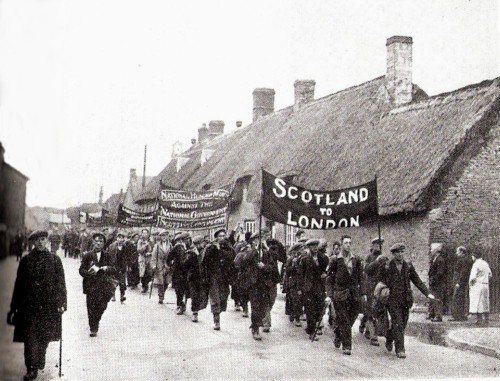
Hunger marchers 1932
(This and the next 4 pictures are taken from Wal Hannington’s book,Unemployed Struggles 1919-1936, Lawrence and Wishart, 1977)
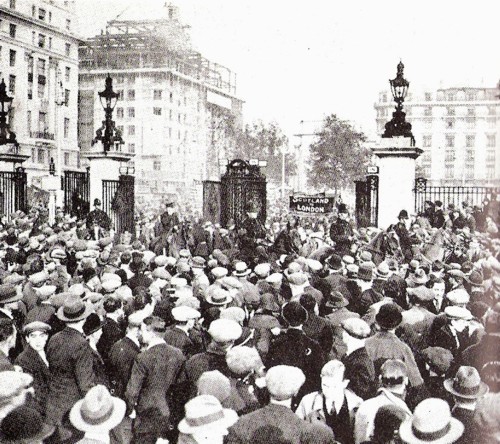
Arriving at Hyde Park 1932
Reuters newsreel report on the marchers’ reception by ‘the most humane force in the world’! (This is the 1932 Hunger March, which has been wrongly labeled on Youtube)
The authorities responded to the rising protests by banning demonstrations in central areas and also by attempting to encourage non-political organisations for the unemployed so as to cut across the NUWM. Similar tactics are used today, but they were not very successful. The NUWM regarded the social service centres, with their games and clothes exchanges, as a deliberate attempt to divert the unemployed from protest action, and they objected to the increasing pressure to make people work for benefits.
At local level, Labour councillors were sometimes able to help mitigate some of the worst impacts of the new regime, especially after 1933 when Labour won control of Glasgow and Greenock. Cautious Glasgow councillors raised relief levels, while Greenock faced down a legal challenge to bring in more generous benefits and modify the means test.
A Royal Commission that reported at the end of 1932 advocated a further tightening of the screws on the unemployed, and was met with further protests. These included another march to Edinburgh when, due to the refusal of the authorities to provide accommodation, over 2,000 men slept along Princes Street. The following unemployed bill, though not quite as bad as the Commission’s proposals, was the subject of major protests both before and after it was passed into law in May 1934.
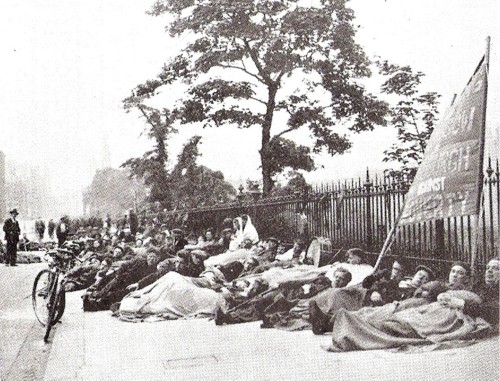
Bedding down in Princes Street, 1933
Another national hunger march had taken place that January and February, and, although the march was opposed by some Labour leaders, this time the NUWM was able to work with the ILP (which had left the Labour Party in 1932) and even some Labour Party organisations. John McGovern, ILP MP for Glasgow Shettleston, marched with the Scottish unemployed workers, and Labour MPs and other Labour Movement leaders spoke at the Hyde Park rally. In London there were mass meetings and demonstrations. A bitter debate in the House of Commons failed (again) to secure the marchers permission to present their grievances directly to parliament, but public sympathies had been stirred and demands to restore the cuts in benefits were coming from all quarters – including the Archbishop of York. The government announced restored benefit levels in the next budget.
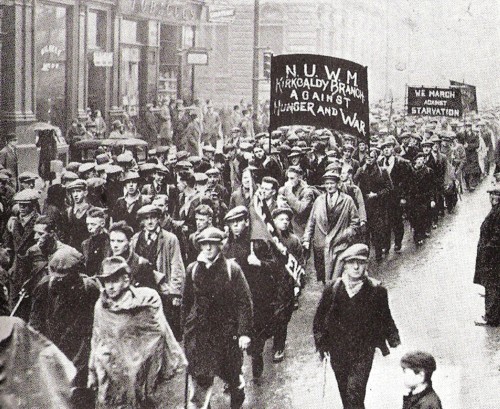
Hunger marchers leave Glasgow 1934
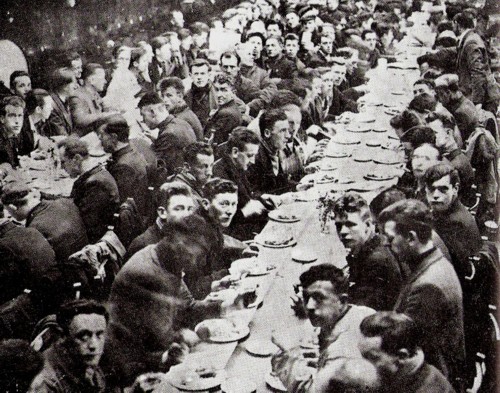
First meal for Scottish marchers in London, 1934
The Unemployment Assistance Board
Part II of the 1934 Act, which came into effect in January 1935, established a new Unemployment Assistance Board (UAB) to provide benefits for all those who had exhausted or did not qualify for insured benefits and bring an end to the variations between local authorities. The UAB officers had to work to new levels of allowances and an even more stringent means test. The new UAB rates were lower than the rate being given by many Local Authority Public Assistance Committees, which had frequently managed to avoid a strict implementation of the government line. There were major protests and appeals to the local authorities, many of whom came out in opposition to the new rates. Shopkeepers, doctors and teachers all added their support to the mass movement. The government was forced to back down and allow areas with higher rates to continue applying these until a new slightly higher scale of benefits was slowly introduced. The new allowances were only finally brought in in Dundee and Glasgow in 1938.
Labour camps
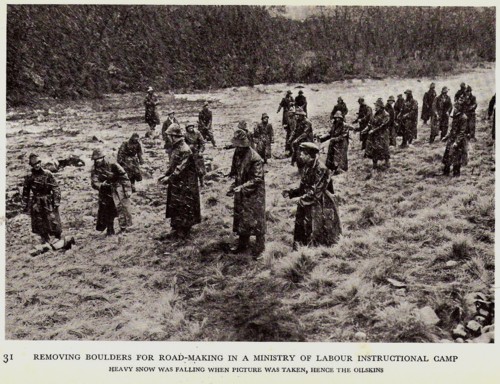
Labour camp illustrated in Wal Hannington’s book, The Problem of the Distressed Areas, Victor Gollancz, 1937
Another focus for concern in the 1934 Act was the drive to expand Government ‘training centres’ or labour camps, and the possibility, allowed in the Act, for these to be made compulsory. There had been various kinds of Government training centres since 1925, but in the thirties they became more widespread. Ministry of Labour Instruction Centres were residential camps based in remote areas where unemployed workers would go for 12 weeks and be put to work on projects such as forest clearing or road-making. Although they never were made compulsory, some people did feel under pressure to go, and anyone who went but left before the end of the 12 weeks would be suspended from benefits for 6 weeks. The work was unpaid, and a large part of the workers’ benefits were deemed to go towards their board and lodging, leaving them with only a few shillings pocket money. At the end of their stay, the great majority returned to life on the dole. They had received little in the way of real training, and anyway there were no jobs to go to. Recently some historians have attempted to dismiss the NUWM’s detailed criticisms of the camps as rabid left-wing propaganda, and present them almost as holiday camps. No doubt, for some unemployed workers who were young and single and went over the summer months, the camps could provide a bit more adventure than their previous existence; and the food, despite many complaints, might sometimes have been better than they got at home. But this is an indictment of the general poverty and desperation of unemployment in the thirties. Hannington records many instances of poor conditions in the camps, and of protests against them, but the NUWM’s fundamental objection was to the fact of people working without pay. They argued that this was demeaning to the worker, and would have a serious impact on wage levels more generally. This is not just a historical argument. Echoes of these schemes appeared under Thatcher in the 80s, and they have come back again with the introduction of ‘workfare’ under New Labour.
The biggest hunger march
The last and biggest national hunger march took place in the autumn of 1936. Two contingents left from Scotland, one travelling down the West of the UK and the other down the East. This time there was much greater involvement by the Labour Party and trade union movement. Local Labour parties helped the marchers, the London Trades Council organised the final reception and Clement Atlee spoke to quarter of a million protestors who gathered in Hyde Park. (The ‘crusade’ organised by Jarrow’s Labour Borough Council took place at the same time, but kept deliberately separate.) The march leaders were allowed, for the first time, to put their case to the Minister of Labour, and there were some concessions made in the UAB Regulations. However, the hated household means test was not replaced by a personal means test until 1941, by which time rearmament and war had all but eliminated unemployment.
AFTER WORLD WAR 2
The Welfare State
Two decades of protest had helped to build public sympathy for the unemployed and draw attention to the economic causes of unemployment. The post-war welfare state built on these changes in attitude and on the new emphasis on economic planning promoted by a war-time economy. But the emphasis on a fairer society was also a response to fears that if the working class were not given a greater stake in British society they might be tempted to adopt a more radical left politics and be attracted to the alternative model of society provided by the Soviet Union. The threat of more revolutionary demands was not far away, and British troops had themselves helped crush revolution in Greece. In 1945, Labour was elected with a large majority indicating a general move to the political left – and the new parliament also included two Communist MPs.
In the new system of National Insurance, which came into effect in 1948, the basic structures around unemployment benefits were not very different to those before the war, but within this structural similarity there were very fundamental changes. Central to these changes was a new perception of unemployment and the unemployed. Under the Welfare State, National Insurance was intended to ensure that people who were unable to work or could not find work would be given the help they needed to lead a decent standard of life without stigma. The Scottish Secretary of State told the House of Commons
We establish in this Bill one of the greatest ambitions of our movement – the establishment of work or maintenance as the moral principle governing the treatment of people who are in need. Under this measure those who get assistance get it without humiliation or abuse.
In practical terms this meant that benefits were much more generous and that the preservation of full employment became regarded as a major government aim.
National Insurance contributions were paid at a flat rate and benefit rates were calculated on the basis of living costs. Generally the same rate of benefit was given for all those unable to earn a living, whether they were unemployed, sick, or retired – plus allowances for dependents. A worker who had paid sufficient National Insurance was entitled to Unemployment Benefit for 6 months. For those not qualifying for insured benefits or needing extra help there were means-tested benefits, which allowed for some savings. Benefits could be suspended for up to 6 weeks if an applicant refused to accept what was deemed suitable employment or training.
However, even more important than changes to the benefit system was the economic boom, which kept unemployment relatively low for the best part of 25 years.
